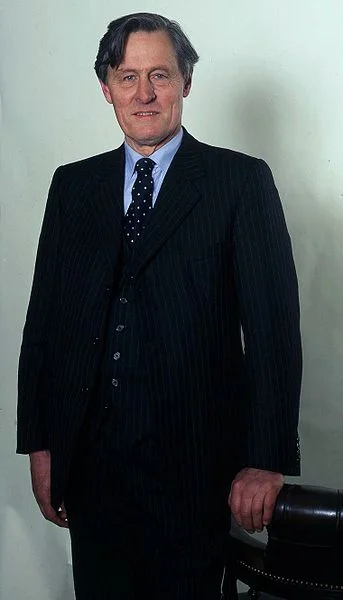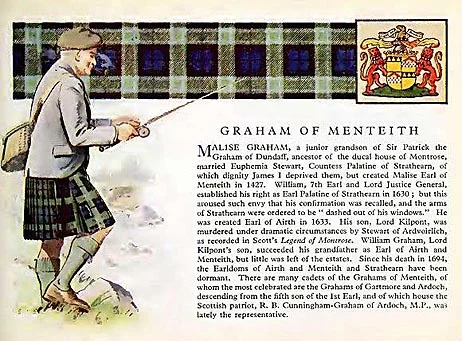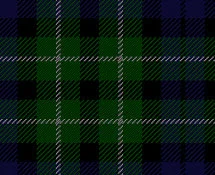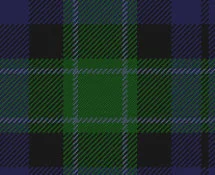“An Greumach Mhor”
Chief of the Clan Graham
James Graham, 8th Duke of Montrose
His Grace was born on April 6, 1935, in Rhodesia/Zimbabwe, Africa, where his father, then the Marquis of Graham, went to establish his career independent of the social ladder which operated in the United Kingdom at that time. The Marquis and his wife were carving a farm out of the African bush. In an effort to escape the attentions of the mosquitoes, the family’s first home was two round mud huts situated on a kopje. It turned out that the situation was not really suitable for young children. After some illness, the Duke and his sister were returned to Great Britain.
The Marquis had attained the rank of Lieutenant in the Royal Naval Volunteer Reserve. At the outbreak of the 2nd World War he joined the Royal Navy and entrusted his farm to a manager. He saw action in the battle of the Mediterranean and duties on the Russian convoy patrols.
His Grace attended two boarding schools. The first had been evacuated to Aberdeenshire for the duration of the war and the second was Loretto School near Edinburgh. The school emphasized a physically tough and Spartan regime, but it also enabled him to learn piping and highland dancing. The former activity has now been passed on to his two sons.
After leaving school, he traveled widely as a volunteer worker. He visited many countries where he took a special interest in the efforts of many of the young countries that were trying to establish their independence and democracy. This was part of various initiatives coordinated by Moral Re-Armament (MRA).
In 1962, he returned to Scotland to oversee some of the family farms and estates. He was finally given full responsibility in 1984. He has been active for many years in his local branch of the Scottish National Farmers Union including serving nine years on the National Council. In 1997, he was President of the Royal Highland and Agricultural Society and has many rural interests.
In 1970, he married a Canadian of Scottish descent, the late Catherine Young, whose father, a Rhode’s Scholar, founded Ravenscourt School in Winnipeg and was one of those killed in the Dieppe Raid of 1942. They have a daughter and two sons – Hermione, James, and Ronald. Hermione is married to Christopher John Thornhill, has twins, and is a psychologist and the President of the Preshal Trust, a charity based in Govan, Glasgow. James (Jamie), the Marquis of Graham, has now taken over the running of the Graham Estate in Scotland and has spent several years promoting renewable energy and anti-pollution measures in China. He speaks Mandarin fluently. He has directed energy exchanges in Europe and now has a position in the UK government. Ronald married Florence Arbuthnott in 2016, has two boys and is a lawyer practicing with a firm in England.
After the death of his father in 1992, His Grace took his seat in the House of Lords and participated in the debates on Scottish devolution and the reform of the House of Lords. In 1999, he was the only Duke elected to remain in the interim House along with 92 other hereditary peers. The Duke is currently the senior peer in government in the House of Lords with roles in farming, fishing, forestry and the environment.
Elected Officers
President
Rev. James B Graham III
Oklahoma
(2020-2024)
president@clangrahamsociety.org
(918) 607-9384
“Do Not Forget” (“Ne Oublie”)
Clan Motto
Clan Colors
Clan Motto
The motto of the Graham Clan is “Ne Oublie.” It means “Do Not Forget.” Frequently we ask, “What are we not to forget?” Historians may have several reasons for this motto which may be based upon biblical teachings.
Clan Colors
The colors for Clan Graham are gold (“or”) and black (“sable”). The armorial bearing for each Graham who is granted arms by the Lord Lyon King of Arms has a modified arrangement of the following: The gold shield and three gold scallops on a black field. Grahams who have not been granted arms may display a simple gold shield with three gold scallops on a black field
His Grace, the 8th Duke of Montrose, was the Honored Guest at the San Diego Highland Games in 1997. The following are a few statements given in his address to the Clan Graham Society:
“On the Graham Coat of Arms are three scallop shells. These represent pilgrimages of three Graham ancestors. The pilgrimages were made by medieval knights to the shrine Santiago de Campostila. Around 1230-1260, pilgrimages were made by two of the senior Dalkeith branches of the Grahams and this was marked by the inclusion of the scallop shells on the Graham Coat of Arms. Shells were used to collect alms for the poor.
“More direct evidence has since been found of the sixth title holder of the Graham of Montrose family. Patrick Graham made two pilgrimages in 1352 and 1361. Official records show he was issued certificates of safe conduct through England.
“My hope would be that those associated with the name of Graham would be a repository of the best of traditions that we are asked not to forget, some of which are contained in the concept of chivalry, bravery and Christian service to your fellow man.”
Definition of the
Word “Clan”
The Gaelic word for “clan” is children, but is best translated as “family.” Originally each clan was made up of the descendents of one man and his children. Today a clan is a social group whose core comprises a number of families derived from, or accepted as being derived from, a common ancestor. Almost without exception, that core is accompanied by a added number of dependent and associated families who have either sought the protection of the clan at some point in history or have been tenants or vassals of its chief.
The clan system which arose in Scotland around the 11th century was a complex society. The clan family was headed by a chief. The chief is owed allegiance by all members of the Clan.
Origins of the Grahams
Scholars have long debated whence came the people and name Graham. Some say the Grahams are descendants of the Graeme who commanded the armies of Fergus II in 404 AD.
Others are equally convinced that they are of Norman descent, while yet others claim a Flemish or even Danish descent. Which are correct? For a complete examination of the subject click HERE to read “Theories on the Origins of the Grahams” by Nellie Graham Lowry, Former Society Genealogist.
Cadets and Septs of the Grahams
The below information was written by Ann Belanger, Past Editor of the Laurel, the Society’s Canadian newsletter.
A clan is a family. Some say that “clans” are highland and “families” are lowland Scotland but this is really a distinction made only in the Victorian era. It no longer applies. A clan or family is a legally recognized group in Scotland, which has a corporate identity in the same way that a company, club or partnership has a corporate identity. A clan or family is a ”noble incorporation” because it has an officially recognized chief or head who (being a nobleman of Scotland) confers his noble status on the clan or family. Thus, by virtue of our Chief (currently the 8th Duke of Montrose) Clan Graham is a true Clan and not just a group of people with the same name associated with them. The direct line of Clan Graham starts from 1125 with William de Graham and continues to the present Duke of Montrose. This main line of the Clan is therefore Montrose.
The Graham family has descended from father to son over the centuries for 30 generations. Throughout all those generations, it was important that members of the family stay “attached” to the clan no matter who they were–younger sons and daughters included. Younger sons formed cadet branches of the family. During the course of time the family left many cadet branches. These are branches from the younger sons rather than the direct line (the branch for the Duke of Montrose coming from the eldest sons).
Unlike daughters of the clan (whose name changed at marriage) sons had options by which they retained their connection to the main branch and the clan. A father might have one son go into the church and have him become a bishop. He would be called Bishop of (his area of jurisdiction). The other sons might be given lands that the father obtained from the king or an earl. The name of the cadet would come from the name of the lands. There are examples of both of these in the cadets below. Note: Each of the cadets has smaller branches from their origins (some of them noted here).
FINTRY AND CLAVERHOUSE
Sir William Graham of Kincardine took as his second wife, Mary Stewart, second daughter of King Robert II. He had five sons–the first was Sir Robert Graham of Strathcarron who is ancestor of the Grahams of Fintry, Claverhouse and Duntrune.
GARVOCK AND BALGOWAN
Another son of Sir William of Kincardine and Mary Stewart was William Graham, ancestor of the Grahams of Garvoch. In 1473, James lll granted the lands of Garvock to the above Sir William and Princess Mary. Later, they were given to the second son, William. A third son, Walter, was the ancestor of the Grahams of Knockdolian.
MENTEITH
The largest branch–the Menteith Grahams–was also created through a royal marriage. Sir Patrick Graham, second son of the Graham chief (Sir Patrick Graham of Dundaff) married Euphemia Stewart, daughter of the Earl of Strathearn and granddaughter of King Robert II. Euphemia succeeded to both her father’s titles after his death (likely about March 1386). As the title of Strathearn was much coveted by King James I, their son, Malise Graham was created Earl of Menteith in return for James I gaining back the Strathearn titles. These are the Grahams of Menteith.
INCHBRAKIE
Patrick was the second son of the 1st Earl of Montrose who was killed at Flodden in 1513 when Patrick was very young. Three months before his death, the Earl gave Patrick a charter which gives to Patrick, and his male heirs, the lands (amongst others) of “Inchbrakie.” These became the Barony of Inchbrakie and Aberuthven and gives rise to the Cadet family of the Grahams of Inchbrakie. Patrick (the first Laird of Inchbrakie) left four children–two sons and two daughters. The eldest son and head of the family, George, took his place eventually as Second Laird. The younger brother, Robert, became Archdeacon of Ross, founder of the family of Graemes of Drynie in the Black Isle, Ross-shire.
GRAHAMS OF THE BORDERS
The origin of this part of the family may have several starting points. One description found in the “Biographical History of the People of Scotland,” published in 1877, says:
“The Grahams of the Borders are descended from Sir John Graham of Kilbryde, called, from his bravery, Sir John ” with the bright sword,” second son of Malise, earl first of Strathern, and afterwards of Menteith, …. The principal families that derive from him are those of Esk and Netherby, which both possess baronetcies, and the Grahams of Plomp, their progenitors having settled in what was called “the debatable land,” a territory consisting of that portion of Cumberland lying immediately to the south of the river Esk and the Solway Firth, and so named from being a constant scene of strife between the Scottish and English borderers. (Note: Sir John “with the bright sword,” was also ancestor of the Grahams of Gartmore in Perthshire. Sir William Graham of Gartmore, created a baronet of Nova Scotia, in 1665, married Elizabeth, second daughter of John Graham, Lord Kilpont, (son of the earl of Airth). (They believe themselves to be of the Menteith branch.)
Addendum to Cadet Branches of Grahams of the Borders
BY JIM NETHERY
GRAHAMS OF ESK, NETHERBY
They are descended from Sir John Graham of Kilbride, second son of Malise, 1st Earl of Menteith and Strathearn*. Sir John married Anne Vere, the daughter of Henry, Earl of Oxford, and they had two sons, William “Lang Will” Graham and Graham of Gartmore.
The Grahams of Esk and Netherby descend from “Lang Will”. He fell into disfavor with the court for possessing lands of the Earl of Morton and because he was collecting tithes for lands that were not his. He lost his lands and was a fugitive at horn, banished from Scotland . He retired with his six sons and many of his kinsmen to the ‘ Debatable Land’ on the south bank of the Esk River near the Solway Firth .
The lands of Netherby went to “Lang Wills” oldest son Richard who built eight Pell towers and it is around one of these that Netherby Hall was built.
GRAHAMS OF GARTMORE
William Graham of Gartmore descended from the Grahams of Duchray who came from the Grahams of Dunans and they traced their heritage back through John (of the bright sword) Graham, of Kilbride to his father Malise Graham, Earl of Strathearn, later 1st Earl of Menteith.** William Graham of Gartmore, was created a baronet of Nova Scotia, in 1665, married Elizabeth, second daughter of John Graham, Lord Kilpont, (son of the Earl of Airth,). Through Elizabeth they are also descended from Sir John Graham of Kilbride.
GRAHAMS OF NORTON-CONYERS
In 1624 Norton-Conyers was sold to the Grahams of Netherby. *** The Grahams of Norton-Conyers are descendents of Richard Graham of Esk, Netherby and Norton-Conyers. His younger son Sir Richard Graham of Norton-Conyers, Yorkshire was created a baronet in 1662. Thus they are also descendents of Sir John Graham of Kilbride, second son of Malise, 1St Earl of Menteith and Strathearn.
*Appropriated by the King James I in 1427 on the basis that the Earldom of Strathearn which he had inherited from his mother, Anne Vere, was a male fiefdom. It became known as the Stewartry of Menteith. In 1631 the Earl of Menteith renewed his claim to Strathearn but was forced to accept the Earldom of Airth instead.
Daughters had the right to remain with their own clan despite her married name. The great Scottish Clans contain families who bore a different surname but were descended from the Chief through the female line. They are called septs. Usually, this came about because the female clan was a stronger one than the male at the time of the marriage and it was, therefore, advantageous for the new husband to swear loyalty to his father-in-law and that clan rather than his own. Because of how septs come about, a family name could easily be listed as a sept of various clans. It would depend on which daughter you were descended from which clan you should be considered a sept member of.
Anybody who has an ancestor bearing a sept name or the clan name itself has the privilege of wearing or displaying the crest badge and indeed only they may legitimately wear an authentic Scottish Ancient Device.
- Airth, Alirdes, Allardes, Allardice, Allardyce*, Allerdyce, Alyrdes, Ardes, Auchinloick
- Ballewen, Blair*, Bonar, Bonnar, Bonner, Bontein, Bontine, Bontyne, Bountene, Buchlyrie, Buchlyry, Bullman, Buntain, Bunten, Buntin, Buntine, Bunting, Bunten, Buntin, Buntyn, Buntyng, Buting
- Conyers, Crampshee, Cramsy, Cransie
- Drumaguhassie, Drumagaassy, Drumaguhassle, Duchray, Duchwray, Dugalston, Durchray
- Esbank
- Fintraie, Fintray, Fintrie
- Glennie, Glenny, Grame, Graeme, Grahame, Grahym, Grim, Grime, Grimes, Grimm
- Hadden, Haddon, Haddin, Haldane*, Halden, Hastie, Haldine, Hasty, Hastiy, Howden, Howe, Howie
- Kilpatrich
- Lingo
- MacCribon, MacGibbon, MacGilvern, MacGilvernock, MacGilvernoel, MacGribon, MacGrime, MacGrimen, Macllvern, Macllvernock, MacKibben, MacKibbin, MacKibbins, MacPiot, MacPiott, MacPotts, MacRibon, MacRigh, MacRis, MacRiss, MacShile, MacShille, MacShillie, Maharg, Menteith, Monteith, Monzie
- Orchille
- Pitcarian, Piatt, Pyatt, Pye, Pyott
- Reddoch, Reddock, Rednock, Riddick, Riddoch, Riddock
- Serjeant, Sirowan, Sterling , Strowan, Strowen
- Clan Allardyce and Haldane have chiefs but have a long historic relationship with Clan Graham and will always be welcomed and protected by the Grahams as part of our family. Clan Blair has no chief at this time and will always be welcomed and protected by the Grahams as a part of our family if they so desire. For more information on the Allardice-Ardis Family Association visit their website at http://www.allardice.org. For Blair surname history and genealogical information, please see http://blairsociety.org/history.html.
Grahym, Grym, Greym, Grahm, Greyme, Graheme, Grahem, Greme, Grahme, Graiham, Greeme, Gram, Grame, Grahame, Graem, Grayme, Graeme, Grayme, Grem, Grimm, Grim, Grehme, Grime, MacCrime, MacGrime, Graham Airth, Gruamach, Grayum
Tartans of the Grahams
The official tartan of the Clan Graham Society is the Modern Montrose Graham. There is an alternative tartan, the Menteith Graham. This provision is made as a courtesy to the descendants of the Menteith Graham (peerage line is extinct). There is also an Ancient Montrose and Menteith tartan being an attempt to reproduce the colors of the older vegetable dyes.
Another tartan associated with Clan Graham is known as the Red Graham. This is the plaid worn by The Great Marquis of Montrose in 1650 when he was sent to the gallows. It was a MacNaughton who gave his red plaid to The Great Marquisto wear to the gallows so at least Montrose would be spared the indignity of being paraded to his death dressed like a pauper. The “Red Montrose” is very similar to the MacNaughton tartan but the position of two colors has been reversed in the Graham.
Clan Plant – The Laurel
(laurus nobilis)
Until recently, the Sparge Laurel has been recognized as the Clan Graham plant. Our Chief and the Lord Lyon conducted an investigation and found that the Sparge Laurel is not indigenous to Scotland and is poisonous. The True Laurel (laurus nobilis), indigenous to Scotland and not poisonous, has been approved by our Chief and is now the Clan plant. The True Laurel is similar to that seen on Greek and Roman noble heads–very fitting as a Graham Clan plant. The Lord Lyon has awarded this change to our Chief.
According to Wikipedia, “The symbolism carried over to Roman culture which held the laurel as a symbol of victory. It is also the source of the words baccalaureate and poet laureate, as well as the expressions ‘assume the laurel’ and ‘resting on one’s laurels.’ In the Bible, the laurel is often an emblem of prosperity and fame. In Christian tradition, it symbolizes the resurrection of Christ.”
Badge and Armorial Bearings
By Richard Graham
North American Chieftain of the Clan Graham
Pictured above on The Clan Graham Society website banner are the official badge (left) and coat of arms (right). Read the important protocol for their use, see illustration details and learn about their historical symbolism
We need to be correct in our use of terminology, badges, arms, mottos and flags. We represent the Clan Graham to the world and our desire is to represent our Clan appropriately.
There is a difference between “The Clan” and “The Clan Graham Society.” When we refer to Clan, we are referring to family. When we refer to the Society, we are referring to an organization. The Clan Graham Society is part of the Clan and it is one of its principle representatives.
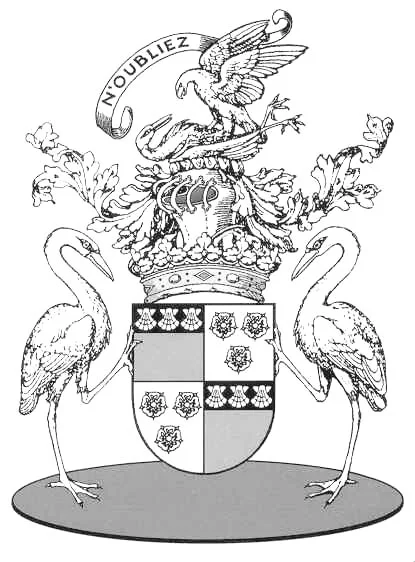
We can never use our Chief’s arms. It should only be displayed when he is present or when it is clearly indicated that it is his coat of arms. The Chief’s arms is not the Graham family arms. Arms are not issued to families; they are issued to individuals.
Our Clan badge shows the crest from our Chief’s coat of arms inside a buckled belt. The badge also shows his motto: “ne oublie” (“forget not” or “never forget”). The Clan Graham News displays this badge on the left side, which denotes greater importance.
The Clan Graham Society’s coat of arms was awarded by the Lord Lyon King of Arms of Scotland, Her Majesty’s Representative for Arms in Scotland. Receiving this award was a distinct honor for the Society. The shield uses the same colors as the Graham shield, but is differenced by the use of connected roundels. It is a gold shield with three gold escallops on black roundels (joined to show unity). Above the shield is a helmet. Above the helmet rests a wreath covered in black and gold (the Graham colors.) On the wreath is a falcon grasping in the right claw three chain links (to show unity.) The escrol above the falcon bears the Society’s motto: “Rioghail Agus Maraon” which means “loyal and united.” The Clan Graham News displays the Society’s coat of arms on the right side. This Coat of Arms is legally reserved for the exclusive use of the Clan Graham Society.
As much as Scotsmen enjoy seeing and flying the “rampant lion,” correct protocol demands that it be used only when the Queen is present. Since this is true, we as Grahams will show our respect by not flying the Lion Rampant flag at our sites. We can be satisfied that others will fly it so we will be able to see its stirring sight.
Further information may be found by researching Scottish heraldry.
There are two versions of the Clan Graham Society crest badge; a black and white version and a colored version. They both include the crest in our Chiefs Coat of Arms, a golden eagle attacking a heron inside a buckled belt containing his motto “NE OUBLIE”. His crest did include a peregrine falcon but our Chief changed this to a golden eagle in 2002 when he was awarded a new standard by The Lord Lyon, King of Arms of Scotland. You will see many versions of this badge, normally worn on a man or woman’s bonnet, designed by silver smiths, vendors and others, but this design you see here belongs to and is legally protected for use only by the Clan Graham Society, Inc.
Both the colored and black and white versions of the Clan Graham Society crest badge are registered by the Clan Graham Society to protect their unofficial use by others. The Society’s coat of Arms is similarly protected.
The Clan Graham Society was honored and recognized in 1992 by The Lord Lyon King of Arms of Scotland when we were awarded our own Clan Graham Society Coat of Arms. This is an honor that has been bestowed on the Clan Graham Society alone. It is protected by registration from misuse by others. With this in mind we continue to follow, respect and recognize the laws of Heraldic Arms of Scotland issued by the Court of the Lord Lyon, with which, coincidentally, the US Heraldic Society also agrees with in most cases.
 The belted crest badge we wear and display includes the crest that sits on top of the Coat of Arms of our Chief, His Grace, the Duke of Montrose. His crest is in the badge and is surrounded by a buckled belt with his motto, Ne Oublie, printed on it. We wear this badge to show allegiance and respect to our Chief recognizing heraldic traditions connected with this Clan Graham Crest Badge.
The belted crest badge we wear and display includes the crest that sits on top of the Coat of Arms of our Chief, His Grace, the Duke of Montrose. His crest is in the badge and is surrounded by a buckled belt with his motto, Ne Oublie, printed on it. We wear this badge to show allegiance and respect to our Chief recognizing heraldic traditions connected with this Clan Graham Crest Badge.
Our Chief, His Grace, The 8th Duke of Montrose and Richard Graham of Lilburn, North American Chieftain of Clan Graham have agreed and approve the following regarding the use of the Clan Graham Crest Badge. We’re most grateful, for input in this matter, from the Lord Lyon King of Arms of Scotland Court Secretary, Lorna Irving the Clan Graham Society President, David Graham, the North American Clan Graham Seanchaidh James Nethery, and the American Heraldry Society, Bruce Durie.
This notice won’t give you the extensive narrative and requirements that govern proper use of the badge but does indicate what the narrative advises. If you are unsure of proper use of the Clan Graham Society crest badge, please ask The Clan Graham Society President, or the North American Clan Graham Chieftain or Seanchaidh for advice.
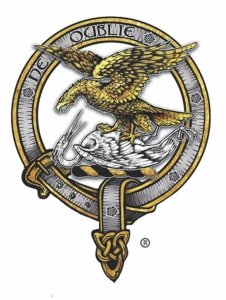 The following statement requires the proper use of an official (not colored) and an unofficial (colored) version of the Clan Graham belted crest badge. The official (not colored badge- see above left) is to be used for official Clan Graham Society representation, in our correspondence, newsletters, Facebook (and other Clan Graham Society sponsored social media) and any displays. We can use the colored version (shown below right) of the badge at special/private meetings or on clothing. The monochrome effect above left, might be preferred by many of you.
The following statement requires the proper use of an official (not colored) and an unofficial (colored) version of the Clan Graham belted crest badge. The official (not colored badge- see above left) is to be used for official Clan Graham Society representation, in our correspondence, newsletters, Facebook (and other Clan Graham Society sponsored social media) and any displays. We can use the colored version (shown below right) of the badge at special/private meetings or on clothing. The monochrome effect above left, might be preferred by many of you.
The Society has registered both versions of the badge for protection against any misuse by others. Please be sure to always display a small ® at the lower right corner of each of these badges just as we should do when we properly display the Clan Graham Society Coat of Arms (Armorial Bearing). This shows that the image is legally protected from any misuse, and that they belong to the Clan Graham Society alone. We may use, at special times, correct colored versions of the Clan Graham Society Coat of Arms without disagreeing with the Lyon Court but again, we should always show that it is protected by depicting it with an ® for protection against its misuse by others.
We know that you will proudly wear and display our clan Crest Badge and Coat of Arms and we thank you very much for following these requirements.
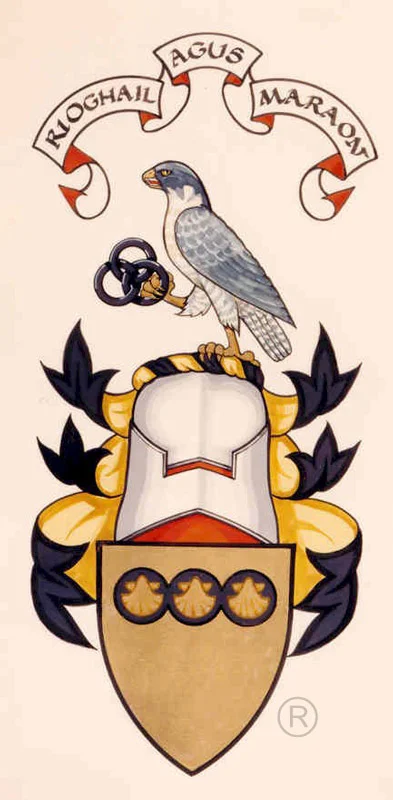 On June 8, 1994, the Clan Graham Society was granted the unique honor of having its own coat of arms approved by the Lord Lyon King of Arms for Scotland. This is the wording of the Lord Lyon’s decree:
On June 8, 1994, the Clan Graham Society was granted the unique honor of having its own coat of arms approved by the Lord Lyon King of Arms for Scotland. This is the wording of the Lord Lyon’s decree:
To all and whom sundry whom these presents do or may concern:
We, Sir Malcolm Rognvald Innis of Edingight, Knight Commander of the Royal Victorian Order, Writer to Her Majesty’s Signet, Lord Lyon King of Arms, send Greeting:
Whereas, Richard Graham, President, for and on behalf of Clan Graham Society, in North America having headquarters at 2563 River Knoll Drive, Lilburn, Georgia, United States of America, having by petition unto us of date 30 June 1993 Shown, that the said Society was founded during the Highland Gathering at Grandfather Mountain, North Carolina, in July 1975; that the said Society has a membership of approximately a thousand people, mainly resident in North America, who have Scottish ancestry with the surname Graham; and the Petitioner having prayed that there might be granted unto him for and on behalf of the Clan Graham Society in North America such Ensigns Armorial as might be found suitable and according to the Laws of Arms.
Know ye therefore that we have devised and do by these presents assign, ratify and confirm unto the Petitioner for and on behalf of Clan Graham Society in North America the following Ensigns Armorial, as depicted upon the margin here of, and matriculated of even date with these presents upon the 120th page of the 75 Volume of the Public Register of ALL Arms and Bearings in Scotland, VIDELICET: Or three pellets conjoined in chief Sable each charged with an escallop Or, Above the Shield is placed an helm suitable to an Incorporation (VIDELICET: – a sallet proper lined Gvles) with a Mantling Sable doubled Or, and on a Wreath of the Liveries is set for Crest a Falcon Proper, armed and beaked Or, grasping in the dexter claw three annulets conjoined Sable, and an Escrol over the same this Motto “RIOGHAIL AGUS MARAON” by demonstration of which Ensigns Armorial the said Clan Graham Society, in North America is amongst all Nobles and in all Places of honor, to be taken, numbered, accounted and received as a Society Noble in the Noblesse of Scotland.
In testimony whereof we have subscribed these presents and the Seal of Our Office is affixed hereto at Edinburgh this 8th day of June in the 43 Year of the Reign of Our Sovereign Lady Elizabeth the Second, by the Grace of God, of the United Kingdom of Great Britain and Northern Ireland, and of her Other Realms and Territories, Queen, head of the Commonwealth, Defender of the Faith, and in the year of Our Lord One Thousand Nine Hundred and Ninety Four.
Read more about our Society’s Protocol and Communication regarding our Chief, Chieftain, flags, banners, symbols and more from Guy Ericskon in this downloadable PDF guidelines HERE.



